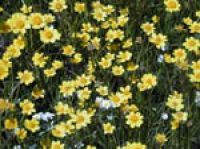Contra Costa goldfields facts for kids
Quick facts for kids Contra Costa goldfields |
|
|---|---|
 |
|
| Conservation status | |
| Scientific classification | |
| Kingdom: | |
| (unranked): | |
| (unranked): | |
| (unranked): | |
| Order: | |
| Family: | |
| Genus: |
Lasthenia
|
| Species: |
L. conjugens
|
| Binomial name | |
| Lasthenia conjugens Greene
|
|
The Contra Costa goldfields (scientific name: Lasthenia conjugens) is a beautiful yellow wildflower. It is an endangered species, meaning it is at risk of disappearing forever. This special plant grows only in a few places in California, USA. You can find it in counties like Napa and Solano.
This plant is an annual herb, which means it lives for only one growing season. It usually blooms from March to June. It loves to grow in vernal pools. These are temporary pools of water that form in spring and dry up later. The plant doesn't grow very high, usually less than 100 meters above sea level.
Scientists have found that this plant used to grow in many more areas. Its historic range included parts of the North Coast, Sacramento Valley, and the San Francisco Bay Area. Even though it grows in vernal pools, experiments show it might prefer slightly drier conditions. It seems to survive in wet areas because it can't compete well with other plants in drier places.
What Does It Look Like?
Lasthenia conjugens is a small plant that grows upright. Its stems can be simple or have many branches. It usually reaches a height of less than 40 centimeters (about 16 inches). Its leaves are smooth and can be up to eight centimeters long. They can be simple or have lobes like a feather.
The flowers grow in single, round clusters. Each cluster has 12 to 18 special leaves called phyllaries. These are joined together for about a third of their length. This is a key way to identify this plant. The flower base is shaped like a dome or cone.
The plant has two types of yellow flowers:
- Ray flowers: These are like the petals you see around the edge. There are usually 6 to 13 of these. They are also yellow and about 5 to 10 millimeters long.
- Disk flowers: These are the many small flowers in the center. They are also yellow.
After flowering, the plant produces small, club-shaped fruits. These fruits are smooth and less than 1.5 millimeters wide. They are black or gray and do not have a feathery top (pappus). This plant needs other plants to cross-pollinate. It has 12 chromosomes (2n=12).
How Does It Live and Grow?
The Contra Costa goldfields needs insects to help it make seeds. This process is called pollination. The seeds then spread mostly by gravity, meaning they fall to the ground. In places where the habitat is not disturbed, special types of bees, mainly from the Andrena genus, pollinate this plant.
Studies have looked at how well these plants grow in natural areas compared to restored areas. Even though different insects visited the plants in restored areas, the plants still produced seeds at a similar rate. This suggests that pollination is not the main problem for the plant's survival. It also means that other insects, like those from the Sciaridae family, might also be good pollinators for this plant.
Protecting This Plant
The number of Contra Costa goldfields plants is going down. The areas where it grows are also shrinking. Historically, it was found in more places, including parts of Contra Costa County and Santa Clara County. By 1995, there were only five known groups of these plants left. All of them were in Napa and Solano Counties.
Scientists have studied the genetic diversity of these plants. They found that planting seeds multiple times in restoration areas helped the new plant groups survive better. They also learned that new plant groups in restored areas can have good genetic diversity. This is important for their long-term health and survival.
The U.S. government listed the Contra Costa goldfields as an endangered species on June 18, 1997. It is also protected by the Solano County Habitat Conservation Plan (HCP). This plan helps protect the vernal pool habitats that are vital for this plant. The HCP also says it's important to protect the genetic differences among the plant groups. This helps keep the entire species strong. However, the State of California does not list it as endangered.
Images for kids



